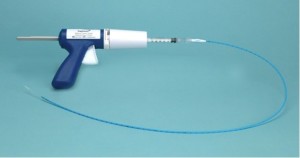Superglue or N-butyl cyanoacrylate has been used for decades in treating cerebral aneurysms and vascular malformations but has only recently been promoted as a treatment for varicose veins. It works by sticking together the walls of the vein rather than destroying the endothelium. A syringe type device is used to deploy the glue along the vein segment to be treated. Like foam, tumescence is not needed as a local anaesthetic so this discomfort is avoided and the treatment is repeatable. In contrast to foam, foreign body material is left behind in the treated vein but there is essentially no risk of micro-bubble embolization. The saphenous veins are the usually the main veins treated.
NICK MORRISON The two challenges of endovenous thermal ablation are the necessity for ultrasound-guided tumescent anaesthesia and the standard requirement of post-procedural compression stockings. An ablation method that eliminates these would seem to represent a significant advance. One such method is the instillation of cyanoacrylate glue into the target vein. This results in the rapid polymerization of the glue upon contact with blood with subsequent damage to the venous endothelium. This progresses to a granulomatous process and eventual fibrosis with gradual resorption of the occlusive polymer. Successful occlusion using a proprietary cyanoacrylate adhesive was first reported by Almeida et al (2011), and later in a European study by Proebstle et al (2013). A multicenter, randomized, controlled FDA trial is ongoing in the U.S. comparing radiofrequency ablation with cyanoacrylate ablation of the great saphenous vein. Cyanoacrylate glue may hold promise for eliminating the two challenges associated with thermal ablation. Long term outcomes and potential side effects are, of course, unknown at this time.
